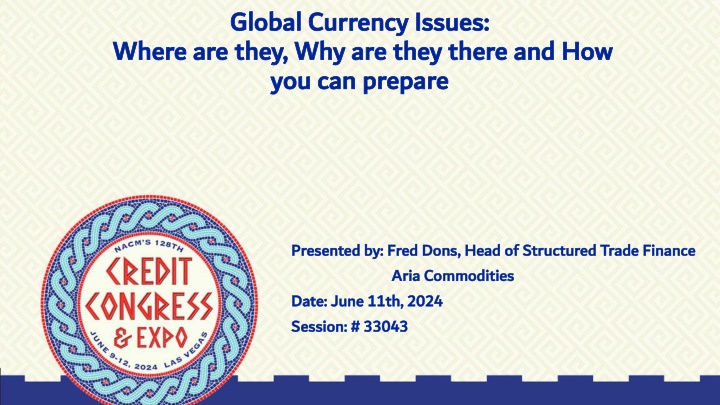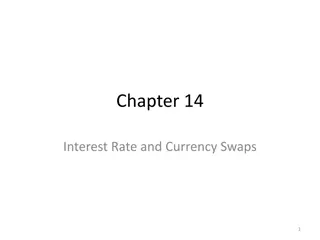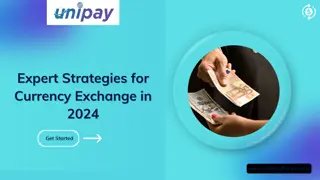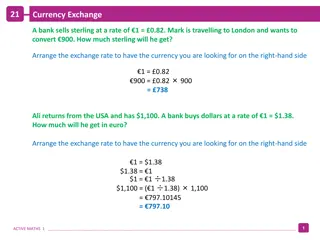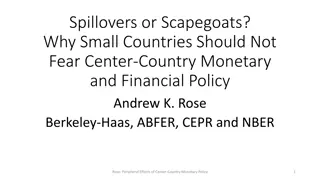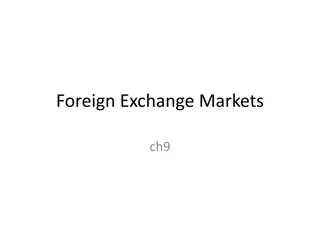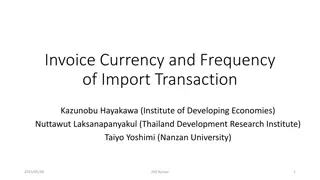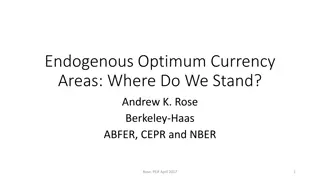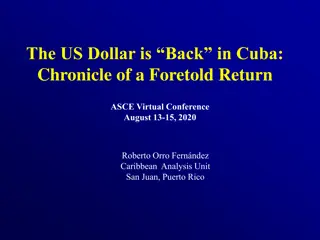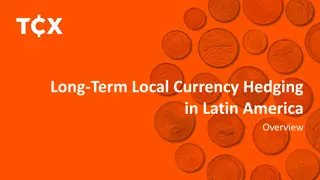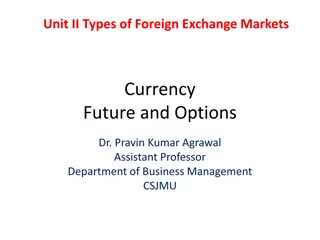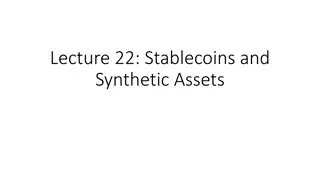Global Currency Issues: Where They Are and How to Prepare
Current state of global currency issues, their causes, and ways to prepare for them. Understand the impact of geopolitical events, economic factors, and market trends on foreign exchange markets. Learn strategies to recognize potential currency risks and mitigate them effectively.
Download Presentation

Please find below an Image/Link to download the presentation.
The content on the website is provided AS IS for your information and personal use only. It may not be sold, licensed, or shared on other websites without obtaining consent from the author.If you encounter any issues during the download, it is possible that the publisher has removed the file from their server.
You are allowed to download the files provided on this website for personal or commercial use, subject to the condition that they are used lawfully. All files are the property of their respective owners.
The content on the website is provided AS IS for your information and personal use only. It may not be sold, licensed, or shared on other websites without obtaining consent from the author.
E N D
Presentation Transcript
Global Currency Issues: Where are they, Why are they there and How you can prepare Global Currency Issues: Where are they, Why are they there and How you can prepare Presented by: Fred Dons, Head of Structured Trade Finance Aria Commodities Date: June 11th, 2024 Session: # 33043 Presented by: Fred Dons, Head of Structured Trade Finance Aria Commodities Date: June 11th, 2024 Session: # 33043
Todays agenda Me A short recap Where are we today What is influencing the availability of foreign currency in a country The cost of oil Revised trade flows The effect of interest rates Some of the hotspots, like Egypt, China, Japan and others How to deal with currency issues, how to recognize and to prepare for it The canary in the coal mine, how to recognize potential issues How to limit them The importance of discipline
A bit about me - I was a banker for 35 years till I finally took the plunge and went over to the dark side and went corporate. Today I m the Head of Trade Finance at a mid-sized commodity trading firm and I m finding our whether the lessons I gave over the years actually hold some value.
A short recap 2023 issues apart from some historical ones, where very much driven by the effects of the Russian invasion into Ukraine. This drove up the prices of energy and caused a shift of major commodity flows from Europe to Asia and back Countries which already had a weak economy, and which were recovering from the covid lockdowns were heavily effected and had to ration their foreign currency reserves. Even countries which had a relatively stronger economy were confronted with new currency flows.
Where are we today The world seems to have found some form of equilibrium post Russian invasion Energy prices have somewhat normalized (especially gas/lng) Flows have somewhat settled New Crisis in the Middle East as a result cargoes around the cape instead of Suez Canal. The effect of countries trying/needing to avoid USD
Where are we today The world seems to have found some form of equilibrium post Russia invasion What does this mean? Flows have settled (with some consequences), historically oil and metal would flow from Russia to Europe, oil would flow from Saudi to Asia This has now reversed and has, amongst others, had its effect on availability of foreign currencies We have new crisis in the Middle East is (cargoes around the cape instead of Suez Canal)
What is influencing the availability of foreign currencies today Those who have listened to one of my presentations before will know I will rarely discuss the actual currency or its exchange rate. I focus more on why certain things are happening in a certain way, so that you can perhaps better prepare yourself for potential issues. The actual cost of energy for a lot of countries. In order to sustain their economy, the oil price needs to be at a certain level The revised trade flows Inflation has calmed down a bit, but it is not far away
The Cost of Oil Why some oil producing countries are struggling Saudi Arabia USD 10 to produce 1 barrel Breakeven point USD 108 Russia USD 15 to produce 1 barrel Breakeven point USD 114 Nigeria USD 48 to produce 1 barrel Breakeven point USD 60 Iran USD 15 to produce 1 barrel Breakeven point USD 112 USA USD 28 to produce 1 barrel USD 38 for existing wells, USD 62 for new drilling Venezuela USD 28 produce to 1 barrel Breakeven USD 57
Revised trade flows The invasion into Ukraine and the follow up sanctions resulted in some major and essential commodity flows having to be redirected Oil from Russia now flows to Asia Same for metal Oil from Saudi now flows to Europe and the US has become a big supplier of LNG to Europe As USD is no longer a currency for goods with a Russian origin, this has also caused a major shift in trade currencies and a lack of USD for some countries
Interest Rates The Western world is eagerly awaiting a lowering of interest rates so that they can go back to borrowing This is probably the reason why central banks are holding off on lowering these rates right now, as we can easily go back to the inflation rates we had 2 years ago A number of countries have ballooned their debt. At some point, all of their available foreign currency reserve will have to be applied to servicing their debt A lower interest will help these countries on the short term. However, if they do not get their house in order after refinancing a default will become inevitable.
Some of the hotspots India Egypt the Middle East Turkey Argentina China Japan Venezuela Honduras
India Elections this year Disparity on economic growth. A large group of young people do not participate in this growth Was able to become a kingpin between Russia and the West. Is stuck with a lot of Rubbles and we still see currency shortage for everything not energy related. On March 29th, India unveiled its new foreign trade policy, which allows the use of rupees in trade with countries facing dollar shortages or currency crises. Malaysia is the latest country to join this scheme. The Reserve Bank of India (RBI), India s central bank, had already decided in July 2022 to allow international trade to be settled in rupees. This move was intended to boost global trade and support the interests of traders who use rupees. India already trades in rupees with Russia, Mauritius, Iran, and Sri Lanka. https://moderndiplomacy.eu/2023/04/30/india-joins- china-in-de-dollarization-drive/
Egypt The good news: IMF has extended its loan by USD 5 billion to USD 8 Billion on the condition that the Egyptian pound will be let to float, making exports more attractive (but imports more expensive) Both the UAE and Saudi Arabia have made significant investments into Egypt (24 billion and 11 billion respectively) This has provided the Egyptian government for sufficient foreign cash at hand for now The bad news: The interest went up with 600 points Poverty has gone up as purchasing power has gone down The vanity project new city capital only increases the government debt Less use of the Suez canal effects income negatively.
Situation in Middle East Attacks on commercial vessels trying to go through the Suez Canal Uncertainty in Strait of Hormuz Effect on the oil price (and subsequent effect on the currencies for those countries dependent on import of oil) , freight charges will be affected, cargoes do take much longer and this does affect the supply chain.
Turkey Inflation is back up to 70 % caused mainly by increased consumer spending and an increase of the minimum wage Exchange rate of the USD is now 32 Lira for a dollar and for Euro it is 34 (in 2006 this was 1,34 and 1,88 respectively) Interest rates went from 8.5 % around the previous elections to 50 % today following a more tighter regime of the central bank. Erdogan has stated he will not be up for re- election. The country did experience a positive economic growth of 4.5%, but investors are cautious to come back and want to see a continuing strict regime on the economy
Argentina Shock therapy Javier Milei hit the ground running. However, he has met strong opposition in parliament. Milei holds only 38 of the total 257 seats and he tried to rule by decree. The majority of his shock therapy has been reversed by the courts in the meantime. His hope is now set on the 2025 elections, hoping to gain a bigger share of the votes Year on Year Inflation is up from 143 % to 257% in February due to the devaluation of the peso. He did manage to balance his budget, but this was the result of cutting a lot of subsidies. This could hinder success in the next election. Milei is continuing to devalue the peso to bring it in line with the unofficial exchange rate. In the longer run this should make Argentina s exports cheaper and make it more interesting for investors. In the short run inflation goes up even further (almost 300% year on year at this moment) Normally, when inflation goes up the Central Bank will increase the interest rate. However, in the case of Argentina, the Central Bank could not afford it due the very popular short term quasi bonds for which it would have to pay out much more interest. This pay out would drive up the inflation due to the influx of more money into the economy
China Inflation close to zero, even deflation for some months Economic growth around 5 % Exchange 1 to 7.25 (USD/RMB) Growth for now but more difficult times ahead due to strained relations with its main trading partners, real estate sector defaults, weak consumer spending, aging population, disparity wealth
Japan After decades of stagflation, Japan is now enjoying inflation The weaker yen has caused an influx of investors, mainly from China and has made exports cheaper for the country. The relatively low energy prices help to counter the lower yen effect
Venezuela Inflation 250 % Although some of the sanctions are lifted, no regular business possible. This is also due to alignment with Russia
Honduras From the Coface website:
What can/should you do Discipline Be prepared Price the risk appropriately Be prepared to step away
Discipline The only way you are guaranteed payment in USD (or Euro for that matter) is to get paid through a confirmed letter of credit If you contractually agreed to receive an LC issued and confirmed by a bank acceptable to you, do not agree to ship until all conditions are met .. in writing ..through your bank. Please note that, although contractually agreed between you and the contracting party, issuing banks have a tendency to forget to ask for confirmation It is quite easy to create an LC which contains traps. Have your checklist ready, work with pre agreed templates, and double check the L/C before releasing any shipment.
Be prepared Have an idea of the local interest rates of your counterpart Know what local currency issues are Know how to price this risk Talk to your bank on what they can do to mitigate these risks and make sure these mitigations are priced into your product. Have a contract and an LC template at hand. It is ok to negotiate and to deviate, but first have something from which you can actually deviate
Pricing the risk If you know the local financing cost of your counterpart and when you know what it will cost you to get any deferred payment discounted by your bank, you know how much room you have to negotiate. The cost of your product should consist not only of the pure manufacturing cost but also your financing costs. This should increase with the risk premium of doing business with the counterpart. Know what these cost actually are and see at what place in the transaction is it most efficient to pay them (sometimes it is cheaper when you pay these costs and integrate them in your cost price) If you accept not having a perfect payment instrument, know how much you can afford to lose and price this into your sale
Be prepared to step away We know the sunken cost fallacy, but can you actually afford to lose a full shipment? We saw in both Egypt and Pakistan that goods were released and payment was postponed indefinitely. Can you afford a 6 month (or more) payment delay ? If you agree to a payment by LC, make sure you can actually meet its conditions. Otherwise, you are just creating a false sense of safety and throwing away good money after bad. Any amendment under an LC needs to be in writing and confirmed by your bank. Your client promising to accept discrepancies is really of no value. If your conditions are not met, the best case scenario is you losing a few days of interest. The worst case is losing the principal amount.
